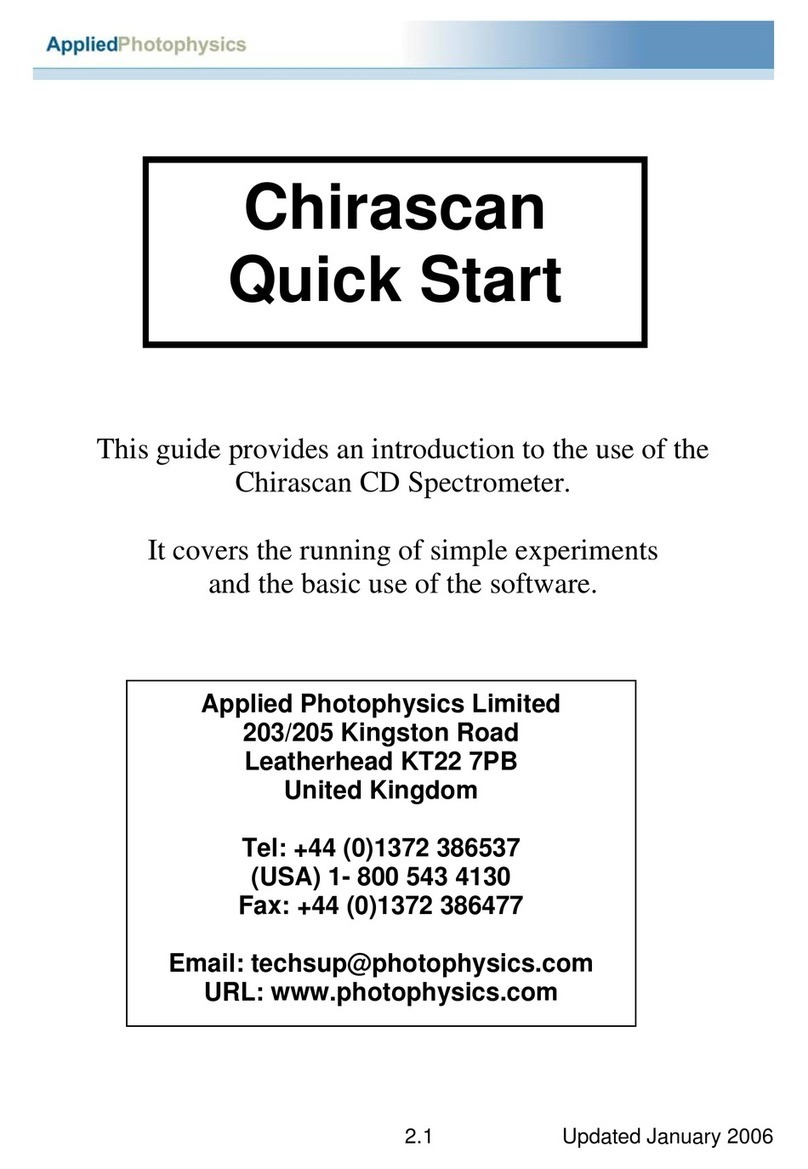USE OF THIS DOCUMENT
This document is intended to inform the operator of Applied Photophysics Chirascan CCD Emission
Fluorometer on its design, installation and operation with the Chirascan V100 Spectrometer and the Single
Cell Peltier Temperature Controller, or the 6-cell Peltier Cell Holder. The CCD Emission Fluorometer is the QE
Pro Scientific-grade type supplied by Ocean Optics Inc., Dunedin, FL, USA, and this document should be used
in conjunction with the User Manuals supplied by Ocean Optics and those applicable to the spectrometer and
the Single Cell Peltier Temperature Controller, or the 6-cell Peltier Cell Holder. It is assumed that the user of
this document is familiar with the operation of the Chirascan spectrometer, and with Applied Photophysics Pro-
Data software. In particular it is assumed that the user is familiar with the hazards associated with the operation
of the spectrometer and the Single Cell Peltier Temperature Controller, or the 6-cell Peltier Cell Holder, and
has read the hazard and other safety information contained in their User Manuals and those supplied by Ocean
Optics.
The information in this document is subject to change without notice and should not be construed as a
commitment by Applied Photophysics, who accept no responsibility for errors that may appear herein. This
document is believed to be complete and accurate at the time of publication, and in no event shall Applied
Photophysics be held responsible for incidental or consequential damages with or arising from the use of this
document.
COPYRIGHT 2018 APPLIED PHOTOPHYSICS LIMITED. ALL RIGHTS RESERVED. THIS DOCUMENT
OR PARTS THEREOF SHALL NOT BE REPRODUCED IN ANY FORM WITHOUT THE WRITTEN
PERMISSION OF THE PUBLISHER.
THE SOFTWARE PROVIDED WITH THE CHIRASCAN AND ITS ACCESSORIES (PRO-DATA CHIRASCAN,
PRO-DATA VIEWER, ETC.) IS THE PROPERTY OF APPLIED PHOTOPHYSICS LIMITED AND IS
SUPPLIED UNDER LICENSE. APPLIED PHOTOPHYSICS IS WILLING TO LICENSE THE SOFTWARE
ONLY UPON THE CONDITION THAT THE LICENSEE ACCEPTS ALL THE TERMS CONTAINED IN THE
LICENSE AGREEMENT. THESE INCLUDE THAT THE LICENSEE MAY NOT SELL, RENT, LOAN OR
OTHERWISE ENCUMBER OR TRANSFER LICENSED SOFTWARE IN WHOLE OR IN PART TO ANY
THIRD PARTY. FOR A FULL COPY OF THE LICENSE PLEASE CONTACT APPLIED PHOTOPHYSICS OR
SEE THE SOFTWARE INSTALLATION DISK.
Chirascan is a trademark of Applied Photophysics Limited.
All other trademarks or registered trademarks are the sole property of their respective owners




























